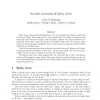Free Online Productivity Tools
i2Speak
i2Symbol
i2OCR
iTex2Img
iWeb2Print
iWeb2Shot
i2Type
iPdf2Split
iPdf2Merge
i2Bopomofo
i2Arabic
i2Style
i2Image
i2PDF
iLatex2Rtf
Sci2ools
ENTCS
2002
2002
Inorder traversal of splay trees
Splay trees, a form of self-adjusting binary tree, were introduced by Sleator and Tarjan in the early 1980s. Their main use is to store ordered lists. The idea is to keep the trees reasonably well balanced through a `splay heuristic.' Sleator and Tarjan showed that if amortised rather than worst-case times are considered, splay trees are optimal. Splay trees have the advantage of simplicity: they are much easier to implement than 2-3 trees, AVL trees, or red-black trees. What if one uses splaying during an inorder traversal of the tree? Sleator and Tarjans' analysis guarantees O(n log(n)) overall cost. On the other hand, the cost of ordinary inorder traversal is linear, whether or not the tree is balanced. We present some data which suggests that the traversal time is O(n), and demonstrate an O(n log log(n)) upper bound. This upper bound is reached through a rather unusual unbounded-history recurrence and by using weaker bounds, such as the O(n log(n)) bound, along the way. ...
ENTCS 2002 | Splay | Splay Tree | Tree |
| Added | 18 Dec 2010 |
| Updated | 18 Dec 2010 |
| Type | Journal |
| Year | 2002 |
| Where | ENTCS |
| Authors | Colm Ó'Dúnlaing |
Comments (0)

